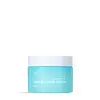What's inside
What's inside
 Key Ingredients
Key Ingredients

No key ingredients
 Benefits
Benefits

 Ingredients Side-by-side
Ingredients Side-by-side

Water
Skin ConditioningCalendula Officinalis Extract
Skin ConditioningGlycerin
HumectantDiheptyl Succinate
EmollientAloe Barbadensis Extract
Skin ConditioningTriethanolamine
BufferingPhenoxyethanol
PreservativeBetaine
HumectantAcrylates/C10-30 Alkyl Acrylate Crosspolymer
Emulsion StabilisingSodium PCA
HumectantPanthenol
Skin ConditioningSodium Gluconate
Skin ConditioningEthylhexylglycerin
Skin ConditioningSodium Lactate
BufferingPCA
HumectantCapryloyl Glycerin/Sebacic Acid Copolymer
Skin ConditioningSerine
MaskingAlanine
MaskingGlycine
BufferingGlutamic Acid
HumectantLysine Hcl
Skin ConditioningThreonine
Arginine
MaskingProline
Skin ConditioningWater, Calendula Officinalis Extract, Glycerin, Diheptyl Succinate, Aloe Barbadensis Extract, Triethanolamine, Phenoxyethanol, Betaine, Acrylates/C10-30 Alkyl Acrylate Crosspolymer, Sodium PCA, Panthenol, Sodium Gluconate, Ethylhexylglycerin, Sodium Lactate, PCA, Capryloyl Glycerin/Sebacic Acid Copolymer, Serine, Alanine, Glycine, Glutamic Acid, Lysine Hcl, Threonine, Arginine, Proline
Anastatica Hierochuntica Extract
AstringentWater
Skin ConditioningButylene Glycol
HumectantGlycerin
HumectantCaprylic/Capric Triglyceride
Masking1,2-Hexanediol
Skin ConditioningCetyl Ethylhexanoate
EmollientPolyglyceryl-3 Distearate
EmulsifyingBehenyl Alcohol
EmollientAcrylates/C10-30 Alkyl Acrylate Crosspolymer
Emulsion StabilisingArginine
MaskingC14-22 Alcohols
Emulsion StabilisingEthylhexylglycerin
Skin ConditioningPropanediol
SolventHydroxyethyl Acrylate/Sodium Acryloyldimethyl Taurate Copolymer
Emulsion StabilisingC12-20 Alkyl Glucoside
EmulsifyingGlyceryl Stearate Citrate
EmollientXanthan Gum
EmulsifyingDisodium EDTA
Salix Alba Bark Extract
AstringentBambusa Vulgaris Water
Skin ConditioningMelia Azadirachta Leaf Extract
Skin ConditioningMelia Azadirachta Flower Extract
Skin ConditioningSorbitan Isostearate
EmulsifyingSodium Hyaluronate
HumectantCoccinia Indica Fruit Extract
Skin ConditioningAloe Barbadensis Flower Extract
EmollientSolanum Melongena Fruit Extract
Skin ConditioningGlucose
HumectantHydrolyzed Hyaluronic Acid
HumectantOcimum Sanctum Leaf Extract
Skin ConditioningCurcuma Longa Root Extract
MaskingCorallina Officinalis Extract
Skin ConditioningSodium Acetylated Hyaluronate
HumectantAnastatica Hierochuntica Extract, Water, Butylene Glycol, Glycerin, Caprylic/Capric Triglyceride, 1,2-Hexanediol, Cetyl Ethylhexanoate, Polyglyceryl-3 Distearate, Behenyl Alcohol, Acrylates/C10-30 Alkyl Acrylate Crosspolymer, Arginine, C14-22 Alcohols, Ethylhexylglycerin, Propanediol, Hydroxyethyl Acrylate/Sodium Acryloyldimethyl Taurate Copolymer, C12-20 Alkyl Glucoside, Glyceryl Stearate Citrate, Xanthan Gum, Disodium EDTA, Salix Alba Bark Extract, Bambusa Vulgaris Water, Melia Azadirachta Leaf Extract, Melia Azadirachta Flower Extract, Sorbitan Isostearate, Sodium Hyaluronate, Coccinia Indica Fruit Extract, Aloe Barbadensis Flower Extract, Solanum Melongena Fruit Extract, Glucose, Hydrolyzed Hyaluronic Acid, Ocimum Sanctum Leaf Extract, Curcuma Longa Root Extract, Corallina Officinalis Extract, Sodium Acetylated Hyaluronate
 Reviews
Reviews

Ingredients Explained
These ingredients are found in both products.
Ingredients higher up in an ingredient list are typically present in a larger amount.
Acrylates/C10-30 Alkyl Acrylate Crosspolymer is a synthetic polymer. It is used to thicken and improve the texture of products. Due to its properties, it can prevent water and oil ingredients from separating.
Arginine is an amino acid that is important for human development. Your body uses is it to produce hair keratin and skin collagen.
As a cosmetic ingredient, Arginine has antioxidant properties and can also help repair damaged skin. This ingredient is derived either synthetically or from animals.
Arginine isn't fungal acne safe when used in the presence of other lipids (fats, fatty acids, oils, esters, etc). Oils and fats occur naturally within the skin, so take caution when using Arginine if you're prone to fungal acne.
Learn more about ArginineEthylhexylglycerin (we can't pronounce this either) is commonly used as a preservative and skin softener. It is derived from glyceryl.
You might see Ethylhexylglycerin often paired with other preservatives such as phenoxyethanol. Ethylhexylglycerin has been found to increase the effectiveness of these other preservatives.
Glycerin is already naturally found in your skin. It helps moisturize and protect your skin.
A study from 2016 found glycerin to be more effective as a humectant than AHAs and hyaluronic acid.
As a humectant, it helps the skin stay hydrated by pulling moisture to your skin. The low molecular weight of glycerin allows it to pull moisture into the deeper layers of your skin.
Hydrated skin improves your skin barrier; Your skin barrier helps protect against irritants and bacteria.
Glycerin has also been found to have antimicrobial and antiviral properties. Due to these properties, glycerin is often used in wound and burn treatments.
In cosmetics, glycerin is usually derived from plants such as soybean or palm. However, it can also be sourced from animals, such as tallow or animal fat.
This ingredient is organic, colorless, odorless, and non-toxic.
Glycerin is the name for this ingredient in American English. British English uses Glycerol/Glycerine.
Learn more about GlycerinWater. It's the most common cosmetic ingredient of all. You'll usually see it at the top of ingredient lists, meaning that it makes up the largest part of the product.
So why is it so popular? Water most often acts as a solvent - this means that it helps dissolve other ingredients into the formulation.
You'll also recognize water as that liquid we all need to stay alive. If you see this, drink a glass of water. Stay hydrated!
Learn more about Water